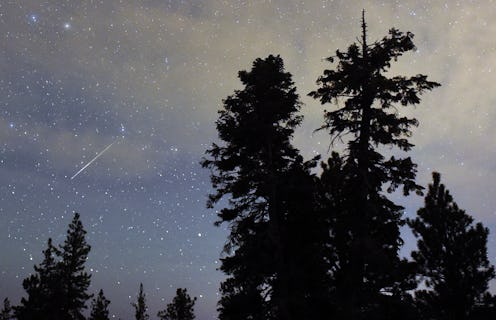Life
What To Know About The Lyrids Meteor Shower

If you're a space geek and love a good sky show, you're definitely going to want to know what the Lyrids meteor shower is, because it's coming soon to a sky near you. Each year — in 2017, it's between the dates of Apr. 16 to Apr. 25 — debris from the comet Thatcher breaks off and becomes vaporized, which in turn provides us mere Earth beings with a light show as it shoots across the sky. So yeah, we effectively have front row seats to epic meteor shower views for days.
Technically, according to Space Weather, the event is the result of when "flakes of comet dust, most no bigger than grains of sand, strike Earth's atmosphere traveling 49 km/s (110,000 mph) and disintegrate as streaks of light." The Lyrids are named after the constellation Lyra, and are considered to be the oldest known meteor shower. The records of this shower go all the way back to 2,700 years. According to EarthSky, the ancient Chinese had observed the Lyrid meteors “falling like rain” in the year 687 BC, making them a historic sight to see.
People watching from the Northern Hemisphere have the best shot of seeing the Lyrids, but people in the mid-Southern Hemisphere latitudes can get a good view if they look up between midnight and dawn. But for everyone, the best time to see the star show is between Apr. 22 and Apr. 23, as that's the peak visibility. The stage of the moon also affects ours ability to see the shower, but because the moon will be in a waning crescent phase in 2017, astronomers believe that we will still get a good contrasted view of the shower this year.
At the show's peak, you might see 10 to 20 meteors an hour, depending on visibility. It's been reported through history that up to 100 meteors per hour have been observed, and though this is rare, it's always a possibility. So you'll definitely want to set your alarm to just before dawn on Apr. 22, you wouldn't want to miss a majorly extra meteor show.
If you live in a big bright city but really want to get a good view of the shower, you might want to consider heading out to the country for a night as light pollution will make it difficult for you to see everything. But if you can't skip town, the best way to view the shower from the city is to head to a dark area. For example, if you live in New York City, don't try to stargaze from Times Square. The darker and more residential the area, the better chance you have at catching a glimpse of the show. If you can find that sweet spot, you won't need any expert equipment, just your eyes and a blanket to lay back and gaze from.